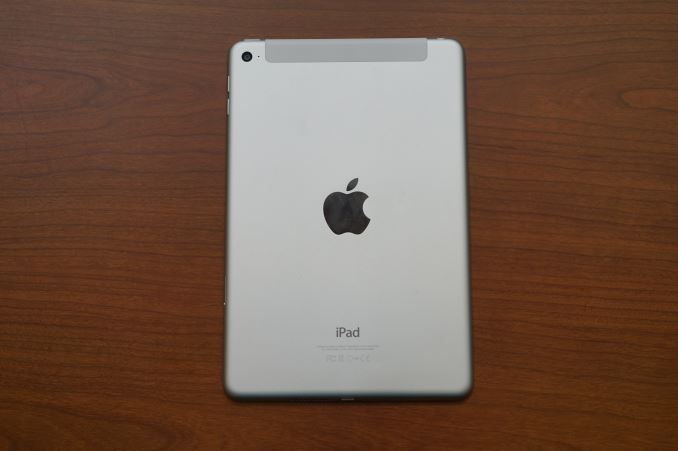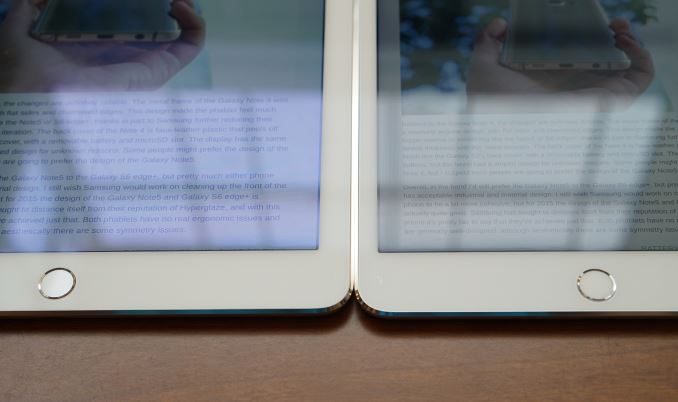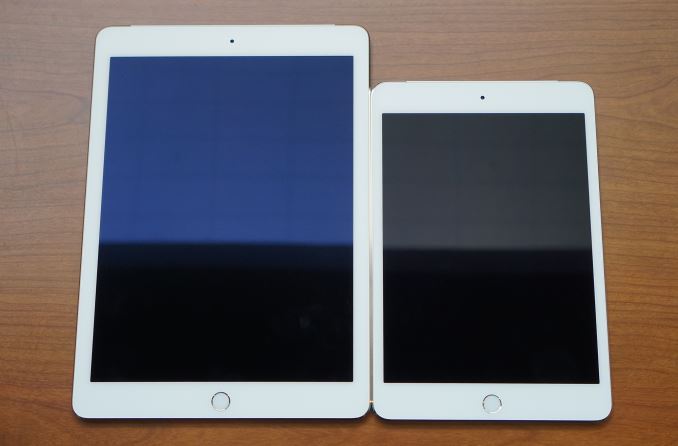The Apple iPad Mini 4 Review
by Brandon Chester on October 28, 2015 8:00 AM EST- Posted in
- Tablets
- Apple
- Mobile
- iPad Mini 4
Final Words
I wasn't very excited about the iPad Mini 3 when Apple announced it last year, as it was just the iPad Mini 2 with Touch ID while the iPad Air 2 was a substantial upgrade from the iPad Air in many ways. The iPad Mini 4 represents an update on the same scale as the Air to Air 2 transition, and it's both highly appreciated and arguably overdue. While many of the changes are actually shared with those made to the iPad Air, some are unique to the Mini either because of its size, or because they occurred on the larger iPad at a previous time. It's worth going over the aspects of the iPad Mini 4 to see whats changed and whether it represents a worthwhile upgrade for existing users or a worthwhile purchase for new adopters.
The build quality of the iPad Mini 4 is as good as the iPad has always been. It's a solid feeling aluminum unibody and there's no flex or creakiness to be found. There isn't really anything other than the Dell Venue 8 that comes close, and I would argue that when you consider design on top of the materials and construction the Mini 4 is definitely the best you'll find in a mini tablet. At 6.1mm thin and 32 grams lighter than the Mini 3 it's also nicer to hold for long periods. I would say that the reduced thickness improves handling more than the small reduction in mass, although the latter can help when holding the tablet for prolonged periods even if it is a pretty small amount.
Performance on the Mini 4 is right where it needs to be as a mini tablet. It's certainly not A8X, but in workloads like web browsing the additional Typhoon CPU core in A8X actually doesn't end up helping all that much. Users who want the absolute best GPU for games and other programs that make use of 3D graphics will want to opt for the Air 2, as while the Mini 4 has good GPU performance for a mini tablet, the GPU in A8X is just really far ahead of everything that isn't powered by an NVIDIA SoC. Apple is clearly aware of the fact that the Mini 4 isn't as capable as the Air 2 for GPU heavy workloads, and this can be seen with the disabled Gaussian blur in the multitasking app tray. While these are definitely things to consider if you need the most GPU power possible, I think most users will find that GX6450 is sufficient for their typical workloads. It's also worth noting that sustained performance in both heavy CPU and GPU scenarios is much farther ahead of competing devices than what is implied by our shorter workload benchmarks that reflect peak performance.
Possibly the biggest contributor to perceived performance has nothing to do with speed or smoothness, but with keeping applications running. The 2GB of RAM in the Mini 4 means that running split screen apps is not a problem, and Safari tabs are no longer killed once you switch to another app or open more than a few at a time. I've mentioned this before, but I think the 2GB transition really should have happened with A7. Regardless, it's finally here now, and that's good news for anyone looking to upgrade or to buy a new iPad.
Next up is the display. This is by far the biggest improvement made going from the Mini 3 to the Mini 4. While Apple was able to make the transition to a Retina display with the second iPad Mini, they had to limit the display's color gamut to do so. This was because of the greater power required by LEDs that had the necessary spectral output to cover the sRGB color gamut. Not only that, but the iPad Mini 3 never received the laminated display of the Air 2, which meant higher reflectance, lower contrast, and a more visible display gap. With the iPad Mini 4 Apple addresses essentially every issue with the previous iPad Mini displays. There's now full coverage of the sRGB color gamut, and an incredible level of accuracy. The display stack is also fully laminated, and the anti-reflective coating from the Air 2 has been brought to the Mini 4. Interestingly, the characteristics of the cover glass mean the iPad Air 2 still ends up being slightly more usable in the sun, but the Mini 4 is still greatly improved compared to its predecessor.
As far as the camera goes, the 8MP rear-facing camera is one of the best on a tablet, and it's a big step up from the 5MP sensor on the last iPad Mini. It's certainly not at the level of the great cameras in devices like the Galaxy S6 or the iPhone, but to take a quick photo in decent lighting it'll do its job fine. The lens flare issues during video recording really let me down though, and because I live in Canada it's not likely that I'll see the sun again for many months in order to check whether this occurs on the Air 2 or if it's unique to the Mini 4. Josh didn't seem to encounter it during his video tests of the Air 2, and on the Mini 4 it's bad enough that I can't really describe the video recording functionality as usable when it's sunny out unless you're facing away from the sun.
The last thing to talk about is battery life. The battery life in web browsing and video playback on the Mini 4 is within Apple's 10 hour target range, which is a good result because a lot of tablet's I've reviewed lately have fallen very short of their battery ratings, and some haven't been confident enough to advertise 10 hours of battery life in the first place. BaseMark OS II shows that the Mini 4 lasts longer than any of the phones or tablets that we've tested in the past, and the CPU throttles far less than any other tablet which leads to higher CPU performance during prolonged CPU workloads compared to the competition, despite also having class leading battery life. This is something that other manufacturers really need to work on, especially at the high end with a tablet like the Air 2 where there's already a significant performance lead before you even factor in that Apple's SoCs throttle less.
The iPad Mini 4 is a long deserved upgrade from the hardware platform that shipped with the Mini 2, and it really makes for a great mini tablet. I do have some uncertainty about the future of the small tablet. From conversations with a few friends it's clear to me that there are groups of people (particularly students) who like the small form factor because it's like carrying a single book that can hold digitized version of big, thick, heavy textbooks, and can be handled even when you're also carrying around a bag and whatever other gear you need. However, Microsoft has pioneered a category of large tablets with the Surface Pro, and both Apple and Google are following suit with the iPad Pro and Pixel C respectively. I don't think the small tablet form factor is going to go away, but I think the market is actually shifting back toward the larger tablet form factors after moving in favor of smaller devices in 2011 and 2012 due to the comparatively large and heavy profiles of the full sized tablets available at that time. You can push more performance, and you have more screen space for multitasking and productivity on a larger tablet.
If you're aiming to create some word documents and spreadsheets, and maybe edit some photos or videos, then I would take a look at the iPad Air 2, or upcoming large tablets like the iPad Pro and the recently released Surface Pro 4 and Surface Book. For the users who lean more toward content consumption and activities like light browsing, reading news, checking social media, and playing games, the iPad Mini 4 will prove to be a great device.













98 Comments
View All Comments
tipoo - Wednesday, October 28, 2015 - link
I wonder if this is pretty much what we can expect from the A8 in the ATV 4. Though it has a heatsink and no battery requirements, so it could go a bit further if they were arsed. Anything coming on that, AT team?Spectrophobic - Wednesday, October 28, 2015 - link
It's a bit insulting that it uses the same SoC as the iPod Touch 6G. I would've preferred a underclocked A8X over a speed-bumped A8, mostly for the A8X's GPU. Considering the typical iPad user, this probably wouldn't be much of an issue as the A8 is still a fast SoC for the mundane things people do.Tech_guy - Wednesday, October 28, 2015 - link
Yeah the GPU in the A8 wasn't designed to push this many pixels. And I hate paying a premium for a year old chip.NetMage - Saturday, October 31, 2015 - link
Paying a premium over what?denem - Wednesday, October 28, 2015 - link
iPad Air Mini 4 should have shipped with an A9 processor, a, TouchID 2 sensor, and, IMO, debuted before the iPhone 6s. The iPad 2 for example introduced the A5 months before the 4s. It was Apple’s most significant platform move ‘evah’. Here is our new technology. This is exciting!“iPad is our most advanced technology in a magical and revolutionary device at an unbelievable price” Steve Job, Jan 28 2010. ‘Magical and Revolutionary’ are smoke and mirrors, but from the iPad 3, the formula became last years technology and yesteryears design. Serviceable? Yes. Exciting? No.
Even when the Air 2 did have genuinely new/interesting advancements: the A8X and 2GB Ram, Apple could hardly bring themselves to talk about it. Nothing should be allowed to detract from the iPhone. If the iPad is less expensive, it must be inferior, or so the thinking goes. Even today, the iPad Pro, which matches iPhone pricing does not sport the new TouchID. Apple’s whole mindset is flawed. An IPad is not a substitute iPhone. Doh.
Tech_guy - Wednesday, October 28, 2015 - link
Yeah I would've bought it for sure with an A9 chip which they easily could've had considering they take less power than A8. The mini 4 GPU is the part that turned me off instantly. Iphone 6 plus GPU performance a year later. No thanks.denem - Thursday, October 29, 2015 - link
And let me guess, an A9 iPad would not have put you off from buying an iPhone if you needed one? No, hand me down technology does not impress anyone, but hey, let's kill enthusiasm and an entire product line while we are at it. Even the iPod got an A8 when it was still current. Bozos.denem - Thursday, October 29, 2015 - link
I guess I should have added that with 4x as many pixels to push, the mini 4's onscreen graphics are slower, a lot slower than the iPod 6. For example, the iPod 6 scores 41.7 fps onscreen for Manhattan HD, GFX Metal, while the iPad mini 4 pushes 15.7. (Source: arstechnica) Double plus stupid.Tech_guy - Thursday, October 29, 2015 - link
Yeah for the mini 4 to be taken seriously by me, a typical power user, it needed better hardware inside. It's literally the performance of an iPhone 6 plus graphics wise, which there's some instances where 6 plus dropped frames and lagged, even in the animations in iOS 9. I have yet to even go look at one because I was SO turned off by A8 rather than A8X or A9. Apple really did exactly everything they needed to do to chase me away from the iPad mini line, and iPad air 2 is too bulky in my personal opinion.akdj - Sunday, November 1, 2015 - link
You guys are hilarious. The A8 is t designed to push this many pixels (I'm writing this on iPad mini 4) but the A5 was? Or the A6x? The A7? I've got an iPad 4 as well as the Air 2 and I've used it daily since its release. It's awesome! Truly phenomenal. I've also used the mini 2 since it dropped. Killer tablet with excellent performance. Even today. It's using an A7 with identical resolution.That said, doubling the memory with the GPU & CPU share makes all the difference in the world. On the iPhone 6s, the Air 2 and now the mini 4.
I've got every triple A title ...if that's what you 'power users' are power using??? (I'm lost and I'm making money with mine!) from the App Store. Every. Single. One. There's not a single app or task i can perform on my Air 2 or iPhone 6s+ that I can't just as efficiently and quickly 'do, play, maiplulate read, consume, watch or produce' on the iPad mini 4. It's been through ten and twelve hour days with me the last few weeks and it's all the Air 2 is - I'll agree in a smaller package.
App developers are currently releasing apps aimed at the A5 & 6 as required hardware. Tomorrow that won't change and if anything will benefit the new mini ...as developers move into the 64bit minimum requirements of the first edition, the A7.
Thought as an actual user, consumer, producer, 'fellow power user?' (I've got a 15" MacBook Pro I typically use for heavy lifting but resources at thee largest tech and software companies in the world are now shifting ...in some cases 'more' resources to mobile than the desk. As a Creative Cloud subscriber since its inception, I'm floored by Adobe's mobile releases. They're incredible and work perfectly with Premier Pro, AE, PS and InDesign. IMHO MS could've left the iPad versions of Word, Excel, Power Point and One Note on v1. They're beyond awesome. I also fly (as a pilot) and rely on the iPad mini as my flight bag. It files my plans, tells me how much gas I need, weather and traffic conditions with up to date Jep charts, plates and NOTAMS. I'm not sure how much more power you're using than I am but there's simply no equal. Anywhere.
You guys all sound goofier than a three dollar bill. A month ago you couldn't get this package of performance. Today you can. It's lacking the A9, but has all other bases covered with display and doubling of RAM, incredible battery life and a smaller package yet YOU'VE got to have the might A9 or the three cores of the A8s ...when I'm absolutely sure as an owners of both you've NECER brought an Air 2 to its knees or limits. If so, please share (I'm aware of two limits on the Air 2 with apps currently available on iOS only ...any guesses?)
I'm honestly curious as to what constitutes a 'power user' of an iPad
Hilarious. Thanks for the laugh
K. Next
Ryan, it's Sunday bro!
:) I kid
Excellent write up as always. Many thanks
J